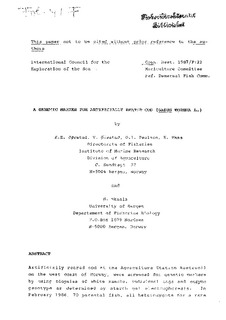| dc.contributor.author | Jørstad, Knut Eirik | |
| dc.contributor.author | Øiestad, Victor | |
| dc.contributor.author | Paulsen, Ole Ingar | |
| dc.contributor.author | Naas, Kjell Emil | |
| dc.contributor.author | Skaala, Øystein | |
| dc.date.accessioned | 2012-07-06T05:38:08Z | |
| dc.date.available | 2012-07-06T05:38:08Z | |
| dc.date.issued | 1987 | |
| dc.identifier.citation | This report is not to be cited without prior reference to the authors | no_NO |
| dc.identifier.uri | http://hdl.handle.net/11250/104318 | |
| dc.description.abstract | Artificially reared cod at the Aquaculture Station Austevoll
on the west coast of Norway, were screened for genetic markers
by using biopsies of white muscle, individual tags and enzyme
genotype as determined by starch gel electrophoresis. In
February 1986, 70 parental fish, all heterozygote for a rare allele in phosphoglucose isomerase (PGI-1(30)), were selected
and placed in a spawning tank. The fish spawned naturally, and
in all samples of offspring the PGI-1(30/30) homozygote accounts
for about 25% of total offspring. At present 3 500 cod are kept
in net pens, where 847 individuals are positively identified as
PGI-1 (30/30) homozygotes and raised as broodstock. Offspring
from this genetically tagged cod will be used in farming and/or
stock enhancement programmes in the future. | no_NO |
| dc.language.iso | eng | no_NO |
| dc.publisher | ICES | no_NO |
| dc.relation.ispartofseries | ICES CM Documents;1987/F:22 | |
| dc.subject | genetics | no_NO |
| dc.subject | genetikk | no_NO |
| dc.subject | farmed fish | no_NO |
| dc.subject | oppdrettsfisk | no_NO |
| dc.title | A genetic marker for artificially reared cod (Gadus morhua L.) | no_NO |
| dc.type | Working paper | no_NO |
| dc.subject.nsi | VDP::Agriculture and fishery disciplines: 900::Fisheries science: 920::Resource biology: 921 | no_NO |
| dc.subject.nsi | VDP::Agriculture and fishery disciplines: 900::Fisheries science: 920::Aquaculture: 922 | no_NO |
| dc.source.pagenumber | 16 s. | no_NO |
